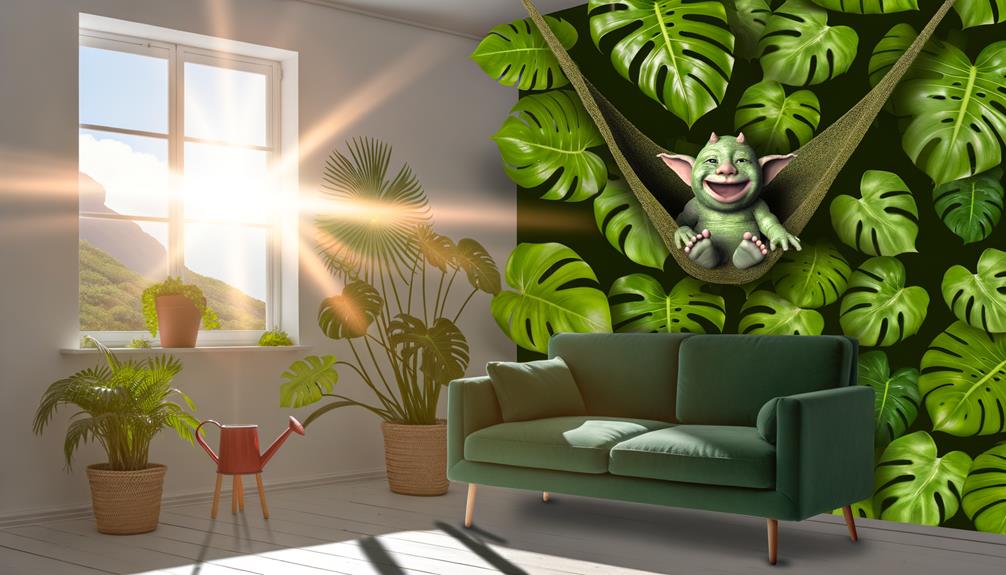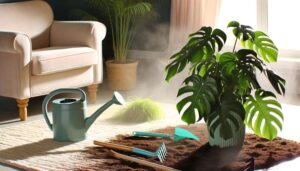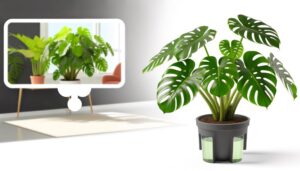Caring for Baby Monsters Deliciosa: A Complete Guide!
To care for your Baby Monsters Deliciosa, provide bright, indirect sunlight. Place it near an east-facing window for ideal light.
Water when the top inch of soil is dry, and monitor for overwatering signs. Use a soil mix of peat moss, perlite, and orchid bark for proper drainage and root health.
Maintain humidity between 60% and 70%, misting leaves with distilled water if needed. Repot into a pot 2 inches larger when necessary, inspecting roots for disease.
Water thoroughly after repotting. Master these steps to optimize your plant thrives and discover additional nuances in its care.

Key Takeaways
- Place in bright, indirect sunlight to enhance leaf color and growth.
- Water when the top inch of soil is dry to prevent root rot.
- Use a soil mix of peat moss, perlite, and orchid bark for optimal drainage.
- Maintain humidity levels between 60% and 70% by misting or using a humidifier.
- Repot into a pot 2 inches larger with well-draining soil to encourage healthy growth.
Light Requirements
Although Baby Monsters Deliciosa can tolerate low light conditions, they thrive best in bright, indirect sunlight. You should place them near an east-facing window where they’ll receive ample morning light without direct exposure.
The best light intensity stimulates photosynthesis, enhancing leaf color and growth. If you notice elongated stems or smaller leaves, it’s a sign of insufficient light. Conversely, direct sunlight can scorch the leaves, causing brown spots.
You can also use sheer curtains to diffuse intense light from a south or west-facing window. Monitor the plant’s response and adjust its position accordingly. Ensuring proper light conditions is important for mimicking the plant’s natural tropical habitat, promoting robust development and overall health.
Watering Schedule
Proper hydration is essential for Baby Monsters Deliciosa, and you’ll need to water them thoroughly when the top inch of soil feels dry to the touch. Overwatering can lead to root rot, so verify the soil has adequate drainage. Typically, watering once a week suffices, but adjust based on humidity and temperature.
| Condition | Watering Frequency |
|---|---|
| High Humidity | Every 10-14 days |
| Low Humidity | Every 5-7 days |
| Cooler Climate | Every 10-12 days |
| Warmer Climate | Every 4-6 days |
Monitor the plant’s leaves for signs of underwatering (wilting, yellowing) or overwatering (mushy stems, black spots). Always use room temperature water to avoid shocking the roots. Consistency is key to maintaining a healthy watering schedule.
Ideal Soil Mix
For best growth, Baby Monsters Deliciosa thrive in a soil mix that balances moisture retention with excellent drainage. Use a blend of peat moss, perlite, and orchid bark.
Peat moss provides moisture retention, ensuring roots remain hydrated. Perlite enhances drainage, preventing root rot by allowing excess water to escape. Orchid bark adds aeration, promoting healthy root development and microbial activity.
Mix these components in a ratio of 2:1:1 (peat moss: perlite: orchid bark). Check the soil’s pH, aiming for a slightly acidic to neutral range (5.5 to 7.0). This composition mimics their natural tropical habitat, ensuring the best nutrient uptake and growth.
Regularly inspect the soil condition and adjust as needed for the healthiest Baby Monsters Deliciosa.
Maintaining Humidity
Maintaining an ideal humidity level, ideally between 60% and 70%, is crucial for the health and growth of Baby Monsters Deliciosa. You’ll need to monitor and adjust humidity to mimic their natural tropical environment. Use a hygrometer to gauge the moisture levels accurately. If the air is too dry, it can stunt growth and cause leaf browning.
To maintain the best humidity:
- Mist the leaves: Use distilled water to avoid mineral buildup.
- Place a humidifier nearby: Helps maintain consistent moisture levels.
- Group plants together: Creates a microenvironment with higher humidity.
- Use a pebble tray: Fill a tray with water and pebbles, placing the pot on top.
These methods help ensure your Baby Monsters Deliciosa thrive in a regulated, humid environment.
Repotting Tips
Repotting Baby Monsters Deliciosa secures they have enough space and nutrients for best growth. First, choose a pot that’s 2 inches larger in diameter than the current one.
Carefully remove the plant, making sure there is minimal root disturbance. Examine the roots for signs of rot or disease. Position the plant in the new pot, adding a well-draining soil mix. Water thoroughly to settle the soil.
Here’s a summary of the process:
| Step | Description | Notes |
|---|---|---|
| Select a pot | 2 inches larger | Ensure it has drainage holes |
| Inspect roots | Check for rot or disease | Prune if necessary |
| Add soil and water | Use well-draining mix, water thoroughly | Settles the soil |
How To Care For Juvenile Monstera Deliciosa?
- Light: Juvenile Monstera deliciosa plants thrive in bright, indirect light. Avoid direct sunlight, which can burn their delicate leaves.
- Watering: Water when the top inch of soil is dry. Overwatering can lead to root rot, so ensure the pot has good drainage. Typically, watering once a week is sufficient.
- Soil: Use a well-draining potting mix, ideally peat-based with added perlite for aeration.
- Humidity: These plants prefer high humidity. Mist the leaves regularly or use a humidifier to maintain moisture levels.
- Temperature: Keep the plant in a warm environment, ideally between 65-80°F (18-27°C). Avoid cold drafts and sudden temperature changes.
- Fertilizer: Feed with a balanced, diluted fertilizer every 4-6 weeks during the growing season (spring and summer).
- Pruning: Remove any yellow or damaged leaves to promote healthy growth.
- Repotting: Repot every 1-2 years or when the plant becomes root-bound, using fresh soil to encourage growth.
By following these care tips, your juvenile Monstera deliciosa will grow healthy and strong.
Conclusion
To sum up, nurturing your baby monsters deliciosa isn’t rocket science, but it does require a touch of finesse. Make sure they bask in indirect light, hydrate them on a balanced schedule, and provide a well-draining soil mix.
Keep the atmosphere comfortably moist and remember, relocating them to a bigger home occasionally will keep them thriving. With these modest adjustments, your green companions will flourish, transforming your space into a botanical haven.
Happy growing!






